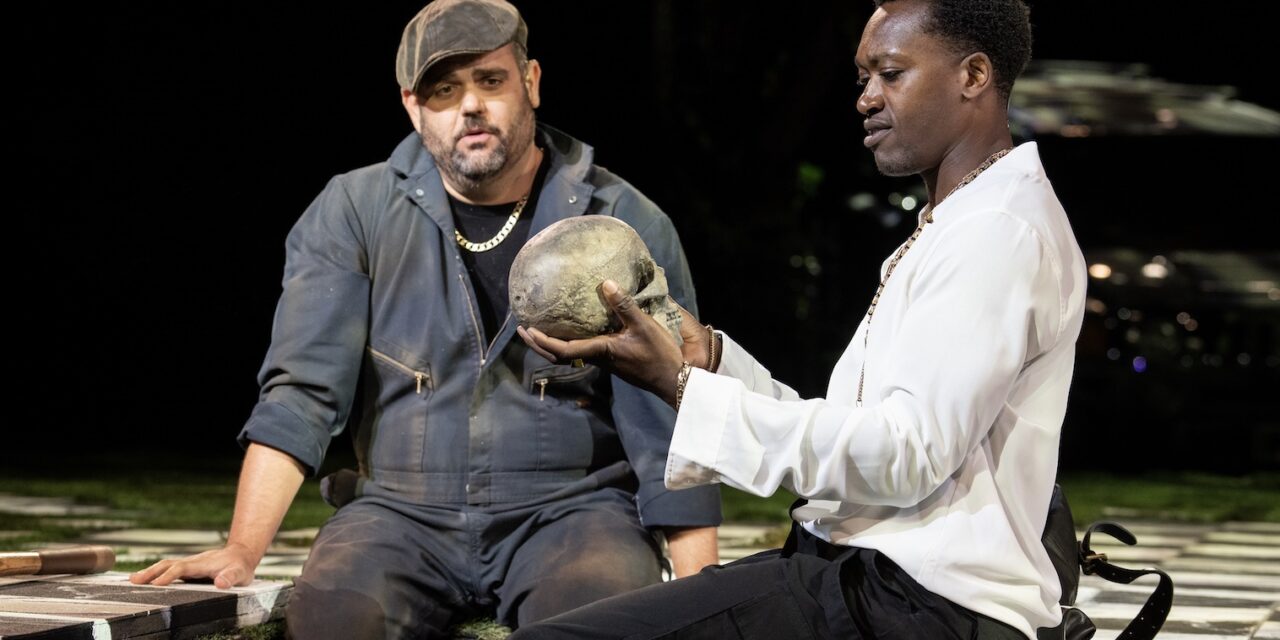By Samuel L. Leiter . . .
For the past couple of weeks, I’d been wondering if my visit to the Free Shakespeare in the Park production of Hamlet was to be or not to be. First, a weather scare kept me away (I’ve been to Park productions in downpours and never want to do it again); then an air quality alert forced my next press booking to be canceled. I finally saw it this week on a classically steamy summer night, the kind that makes you admire the fortitude of actors who can rush around for nearly three hours fully costumed, emoting in iambic pentameter, while you congratulate yourself for having worn shorts and sandals.
Unfortunately, this Hamlet, the Delacorte’s last show before it closes for a much-needed two-year renovation (which I hope includes the presently disgusting men’s room), directed by the red-hot Tony winner Kenny Leon (Top Dog/Underdog), is, by and large, a dud. To begin with, it uses a deconstructed version of the set Beowulf Boritt created for Much Ado about Nothing, directed by Leon in 2019, the venue’s last show before Covid hit. Having missed that production, I know the set’s origin only from having read about it.
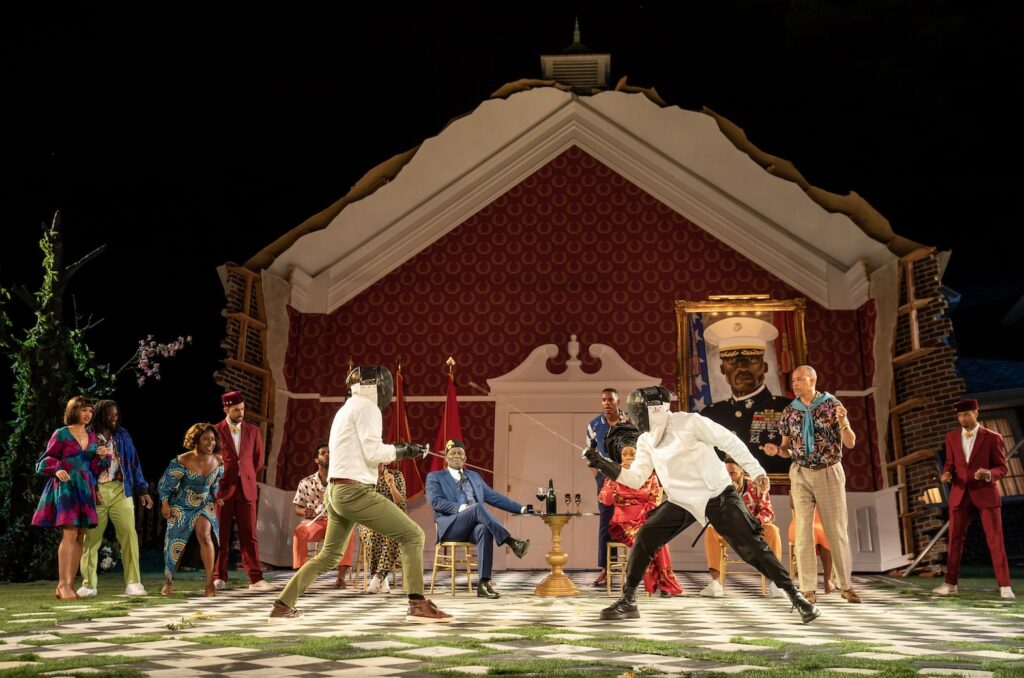
It shows a Southern estate with a stuck SUV (never used) off to one side; what looks like the great hall of a Southern mansion whose side walls have crumbled; a large, fallen, Stacy Abrams 2020 poster; a toppling American flagpole, flag attached; and a house slanted at a precarious angle as if sinking into the earth. What anyone not knowing its background makes of this scenic farrago, I can’t imagine; even knowing from whence it derives doesn’t help it make sense within the context of Hamlet, regardless of what’s rotten in Denmark. Nothing in how the characters look or behave makes any reference to the post-apocalyptic scenery.
Of course, this is a modern-dress Hamlet, the cast dominated by actors of color, but with important roles such as Polonius (Daniel Pearce) and Laertes (Nick Rehberger), among a few others, by whites. Costumer Jessica Jahn dresses Hamlet (Ato Blankson-Wood) in black, military-style jeans tucked into combat boots, with several different tops ranging from black to white; Claudius (John Douglas Thompson) is in a three-piece blue suit, occasionally with an African-style cap; Gertrude (Lorraine Toussaint) wears African-Caribbean influenced outfits; Ophelia (Solea Pfeiffer), in the earlier scenes, is in above-the-ankle-length jeans, short, satin Eisenhower jacket, and a shoulderless top. Everyone else wears some version of contemporary cool, some looking like club kids out to party.
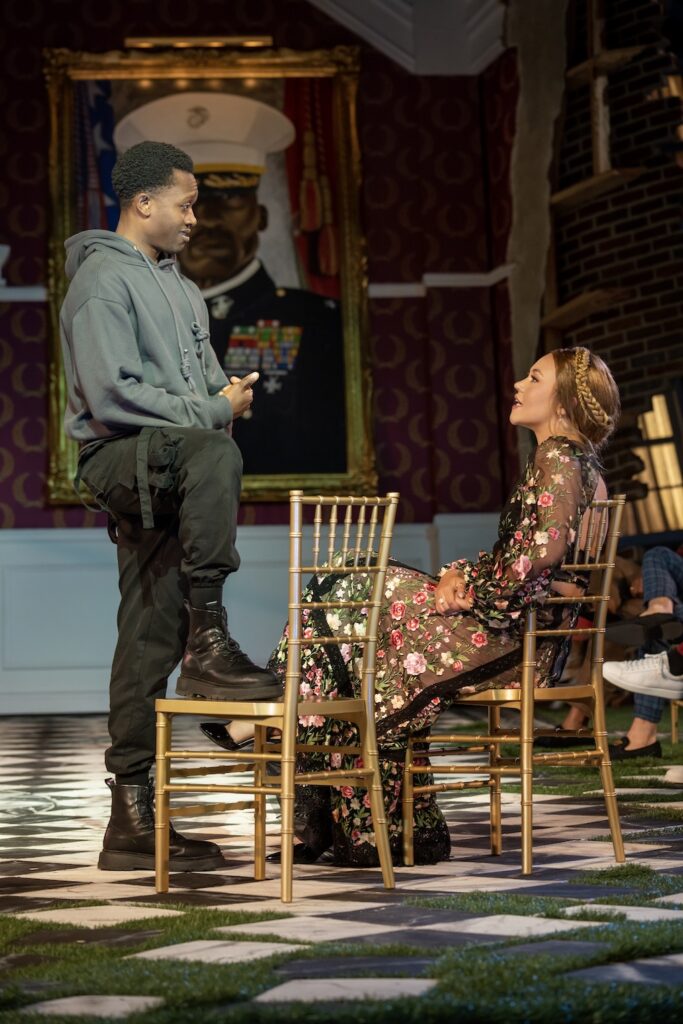

As per convention, the play has been greatly cut to get it over before 11:00 PM. Those familiar with Hamlet will, as always, regret the many cuts (including the entire Fortinbras subplot), but the current script also takes liberties with Shakespeare’s words, like replacing the Player’s speech about Hecuba with hip-hop lyrics, making the performer a rapper. Thus when Hamlet is disgusted at what he perceives as his own emotional limitations when compared to the professional actor, he’s unable to complain “What’s he to Hecuba, or Hecuba to him,” etc.
The opening on the battlements when the ghost is spotted is replaced by a series of gospel songs sung acapella over the corpse of the late King Hamlet, using up time that could better have been used for expository business. And when the ghost (the voice of Samuel L. Jackson) finally does appear, it’s by cheesy special effects in the form of video (designed by Jeff Sugg) and amped-up sound (designed by Justin Ellington). Since the 19th century directors have sought to indicate the ghost by other than the presence of a visible actor. It rarely works; the present case is among the phoniest I’ve ever seen.
Despite the numerous gimmicks, there are some bright spots. During the play-within-the-play sequence, Ophelia takes a surprisingly snippy attitude toward Hamlet, who a bit earlier demeaned her in the “Get thee to a nunnery scene.” Given that the play will soon show her as having lost her mind, this show of agency is completely illogical, but it’s refreshing to see her striking back, even momentarily. It’s also nice to see the Laertes duel with Hamlet staged by Thomas Schall with actual foils, rather than the multiple other weapons modern directors like to play with. It’s not the greatest Hamlet duel I’ve seen over the past 60 years (the first featured Donald Madden in 1961), but it does the job.
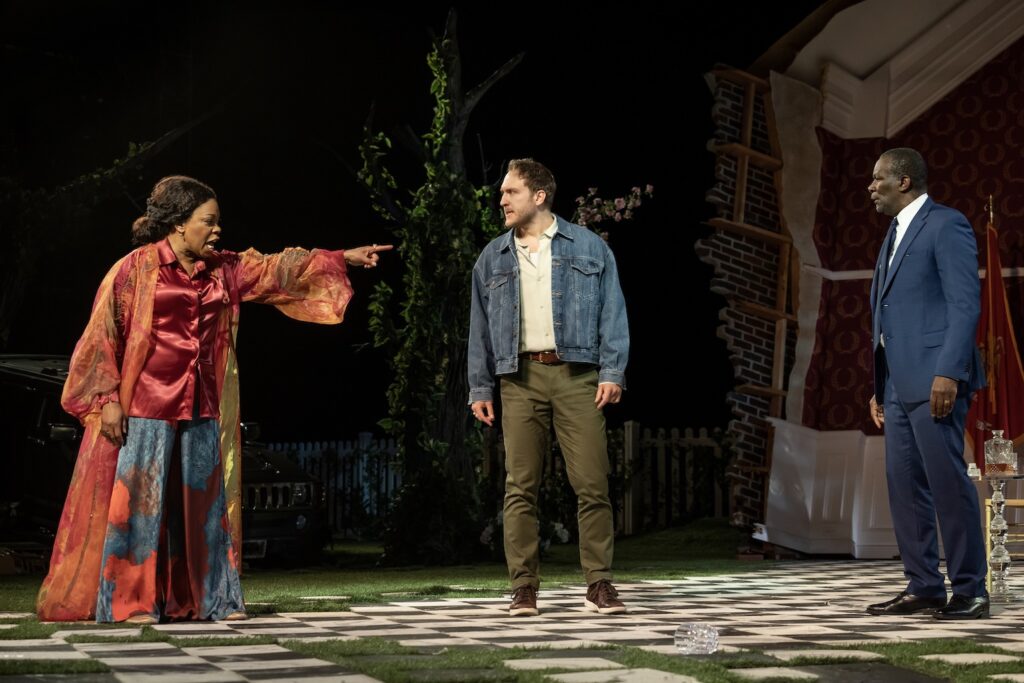

Regardless of what Laurence Olivier says in his film version, Hamlet is not about a man who could not make up his mind. Once he has the motivation provided by the ghost’s demand for revenge, he’s dead-set on carrying it out, albeit constantly deflected by events. Ato Blankson-Wood presents a beautifully spoken, emotionally tense prince, but he is too persistently angry and bitter. He rarely projects someone determined at all costs to meet his dead father’s wishes, his focus too often being on the moment rather than the goal. He fails to capture the prince’s sense of satirical mockery by playing mind games with his enemies to fool them into thinking him mad.
None of the arrows in his quiver is called “Charm,” although that quality is clearly within Blankson-Wood’s range. The rationale for his turning viciously on Ophelia is puzzling, nothing being offered to explain why, for example, he says, “Where’s your father?” which puts him on the offensive. And for all his clarity of speech, he misses too many nuances. For example, the casualness with which he asks, having blindly killed the hiding Polonius, “Is it the king?” is a throwaway rather than the excited reaction of someone who may just have accomplished his long-sought goal.
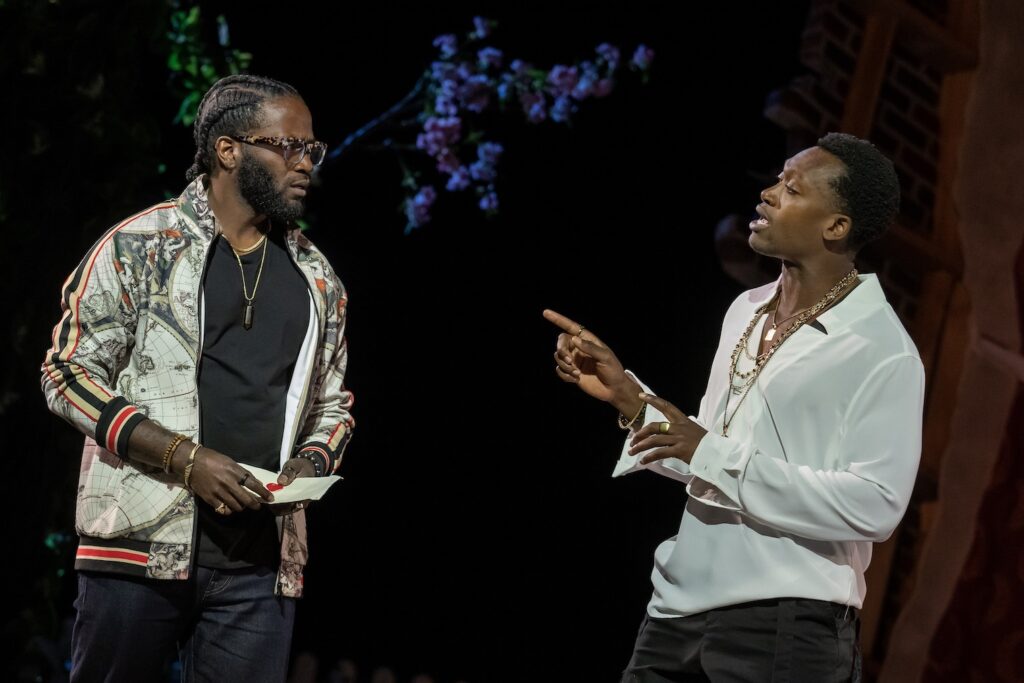

John Douglas Thompson comes close to capturing the essence of the troubled Claudius, but even this noble actor can’t avoid expressing his feelings in the most heartfelt scenes by shouting them. There are, sadly, no surprise performances in this largely run-of-the-mill production. Lorraine Toussaint is a respectable Gertrude, showing palpable sexual interest in Claudius, as well as a fondness for drink (later connected to her death). Solea Pfeiffer is a stunning Ophelia with a decidedly fresh tint, but her madness seems to come from nowhere, especially when she appears for her big scene wearing a fashionably attractive pants suit-like negligee, her artfully permed hair flowing like a pre-Raphaelite Bernadette Peters. She seems to have gone to a lot of trouble to look good when she tosses those flowers about.
It’s too bad the old Delacorte must bow out with this less-than-stellar version of Shakespeare’s greatest play. I attended the theater’s opening in 1962, when George C. Scott proved an unforgettable Shylock. My college theater design professor, Eldon Elder, designed the place, so we all glowed by association with him and his achievement. Like every New York theatergoer, I look forward to the reopening in 2025, hoping that the new Delacorte (and its restroom facilities) will not only be beautiful but serve for many more years as one of the city’s brightest sights.
Hamlet. Through August 6 at the Delacorte Theater (in Central Park at West 81st Street and Central Park West). Two hours 45 minutes with one intermission. www.publictheater.org
Photos: Joan Marcus
Cover phioto: Greg Hildreth and Ato Blankson-Wood


